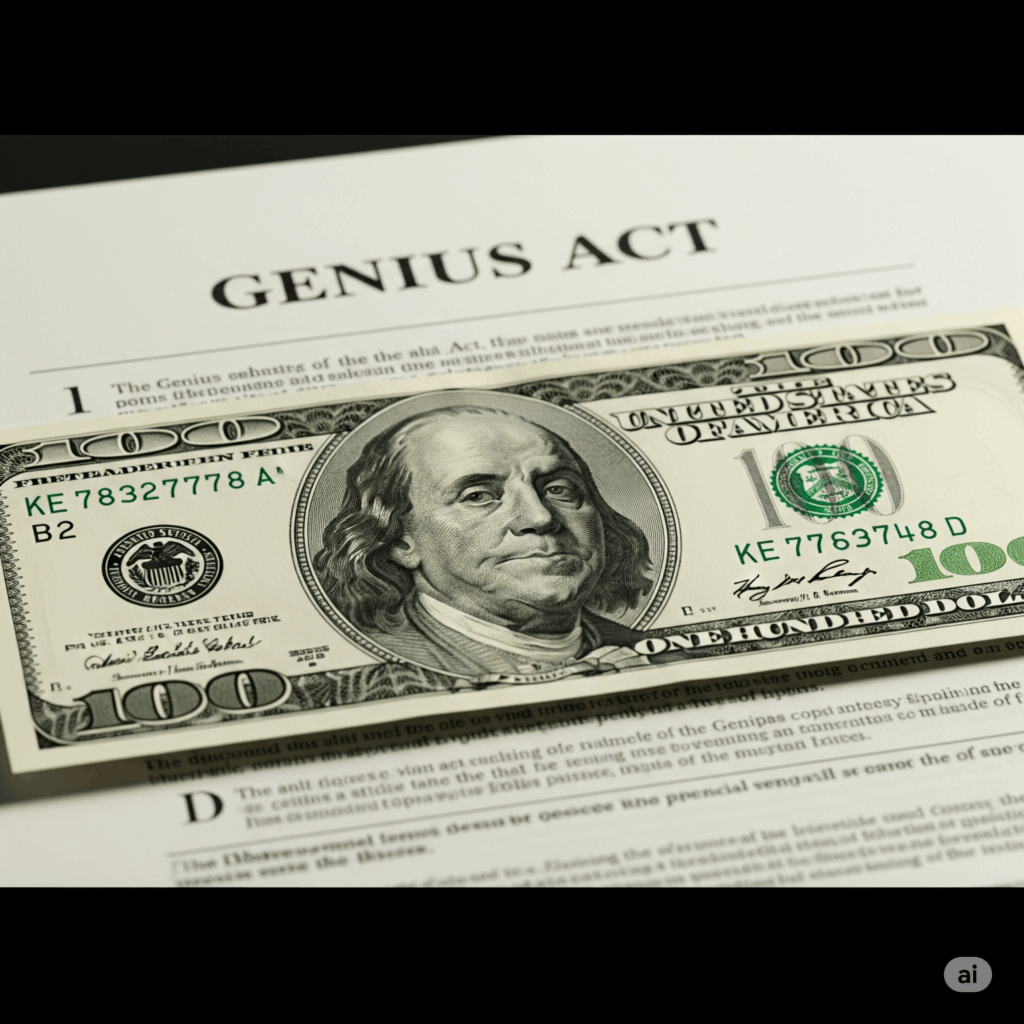Crypto: The Genius Act and More
 Crypto, stablecoins, blockchain. I’ve hesitated to introduce these subjects into my writing because I think they are largely a distraction from what should be the prime focus of public funds investors, but the Genius Act, hailed by President Trump when he signed it last week as “making America the leader in digital assets” took me over the threshold, so here goes.
Crypto, stablecoins, blockchain. I’ve hesitated to introduce these subjects into my writing because I think they are largely a distraction from what should be the prime focus of public funds investors, but the Genius Act, hailed by President Trump when he signed it last week as “making America the leader in digital assets” took me over the threshold, so here goes.
I’ll begin with this: Crypto is a shiny object that now has the attention of much of the investor community but whether it will bring real value to investors is TBD. Meanwhile, though, it commands notice and will move markets. Stablecoins, the subject of the Genius Act, are and will be promoted as a revolutionary way to improve market efficiency by using blockchain technology to record and move certain assets (currency). Tech venturers sense opportunity (AKA profit), banks and money market funds have joined the game, if only because they do not want to be left behind as the basis for their franchise is challenged, and the market overall is a bit breathless over it. Add AI and. . . .
But I digress. Behind the enormous crypto hype with its financial and tech industry barkers it’s hard to discern any near-term economic value for public funds investors. Time and future developments will determine whether there is any value down the road, but for now stablecoins seem to fit poorly with the main goals of preserving principal and providing liquidity.
Deep Dive
Blockchain technology and decentralized ledgers are at the heart of the stablecoin industry. They hold out the promise of radical changes in the way financial value is stored and transferred. This promise has been live since the technology was rolled out in 2009; fifteen years later it’s challenging to identify any large scale examples of implementation that have improved efficiency or safety. Not that it won’t happen, but the financial markets framework, built over a couple of hundred years, is enormously complicated and slow to change. That’s not necessarily bad, but it means change takes time and likely entails lots of false starts, blind alleys and dead ends along the way. So we’ll see.
Blockchain technology spawned stablecoins, tokens that promise to maintain a constant value and provide nearly instantaneous liquidity. In this way they seek to mimic currency, and someday they may in fact be currency, but that’s not the case today. At the heart of stablecoins is that the value stored is not native to them; rather it is in their convertibility to dollars (or another established currency). For the most part you can’t pay for a pound of butter, a gallon of gas or your property tax bill in stablecoin tokens. You first must convert them by “selling” them for dollars. (Stablecoins may be spent directly—i.e. without converting—to pay for some other crypto assets or may be pledged as collateral in certain transactions. But such transactions are not everyday ones, or even occasional ones for public units.)
Converting stablecoins to the coin of the realm (USD) has a cost. For Tether it’s recently been about one basis point, or $100 per million. This is the bid/asked spread because like other financial assets that trade there is a market maker in the middle. True you can transfer stablecoins directly (peer to peer) but to do so you must first convert dollars to tokens (at the asked price) and ultimately they will be converted back to fiat currency (at the bid price) to be used to pay for things. $100 per million is not much if you do a conversion transaction, say, once a year. But if you have stablecoins in circulation, this cost can accumulate and reduce the value of the coin materially. By contrast the bid/asked spread on a three month Treasury bill is around $25 per million, so one could say that it costs four times as much to obtain stablecoin liquidity as it does liquidity in a Treasury bill. And the cost of investing in an redeeming a share in a stable value LGIP or money market fund is zero since all transactions are normally done at the net asset value.
Unlike fiat currency that’s worth $1 because the sovereign says it is, and economic actors accept this as fact, stablecoins need something else of value to back the promise of their worth. Stablecoins in their native form lack the full faith and credit backing of Federal deposit insurance or the closely-managed portfolios of government money market fund portfolios. To assure holders, issuers back them with collateral or reserves which may be fiat currency or short term securities that are supposed to be nearly equivalent to currency, or may be cryptocurrency collateral or commodity collateral. If that sounds a bit vague, well it is, at least when compared with the portfolio holdings of a money fund or LGIP.
Nor are stablecoins interchangeable in value. Tether, which represents nearly 80% of the outstandings is convertible to U.S. dollars at $1.0004 at this writing; USD Coin, thought to have the second largest market share is worth $0.9999. And the relative values fluctuate. Just as in the wildcat banking days of the early nineteenth century when bank notes were common and before fiat currency became the law of the land, there are more valuable and less valuable coins.
Stablecoins do not pay interest or a dividend so holding “money” in a stablecoin means foregoing earning interest on the balance. With short term interest rates at four percent plus this is not an insignificant cost.
Finally, in the event of a run the stablecoin issuer would have to liquidate reserves to maintain the stablecoin value. This raises the possibility of liquidity issues like those that roiled the financial markets in 2008, 2020 and 2023.
And yet stablecoins represent a market capitalization of $250 billion, and some commentators see this growing to the trillions before long. If you are a believer in efficient market theory, you might wonder where this value comes from. Who would be willing to forego interest at four percent and accept the cost and risk of conversion? Economists point to a number of actors.
If you are part of the underground economy the anonymity of stablecoins may well be worth the bargain. Analysts estimate the underground economy amounts to about 12% of global gross domestic product (!), or nearly $13 trillion. Some economists estimate its value to be higher. Ken Rogoff, a well-known monetary economist estimated it to be $20 trillion globally and $1.4 trillion for the U.S. economy. This may be enough to fuel a large stablecoin business even after discounting the value of coins by costs, risks, and foregone earnings.
Think that’s a ridiculous analysis? Consider this: An alternate vehicle for storing value is the U.S. $100 bill. In 2024 $1.9 trillion, or more than 80% of the value of outstanding currency was in Bens, (mostly held outside of the U.S.) Value stored this way earns no interest and incurs significant storage and movement/transfer costs. Yet those in some segments of the U.S. and global economy are content with these costs.
Another source of value might be characterized as meme investors. They may be moved by factors other than the pure economics of a transaction. Conventional economics might argue against holding stablecoins but might I buy $500 worth just to have it and give me something to talk about over a beer with a few of my crypto bro friends? After all, $500 is not that much to commit. Even if the commitment is frivolous and if I stand to lose 20% of the value, the value at risk might be less than the cost of a night out. If 50 million bros around the world—novice bond traders, Uber drivers, restaurant servers and tech geeks—hop into the trade “just because” that would represent $25 billion of assets. Not a bad base for an asset class.
Outside of the world of dark activities or social networks there is a case to be made around the efficiency of blockchain technology. Stablecoin advocates preach that the tokens reduce or eliminate the “friction” around transfers/payments. This friction means, for example, that money and assets move on a same-day basis but not instantaneously in the banking system and in the money fund space. Blockchain-based transactions could be nearly instantaneous with assets changing hands as soon as individual wallets are updated. Accelerating transfer time to seconds via tokens, though, comes at a cost. As I’ve observed, if you start with dollars, buy stablecoins to store the value, then convert stablecoins back to dollars to make payments you are captive to the bid/offered spread associated with the token. The bid/offered spread doesn’t exist for shares in money market funds or in dollar denominated deposit accounts. So trade same day for instantaneous and interest earned for bid offered spread. Whether the value of eliminating this friction is worth it for public funds investors seems dubious at this point.
Bottom Line.
All of this is alternately intriguing, somewhat confusing, opaque, potentially groundbreaking. Stablecoins are at a stage where the traditional banking/finance industry is being challenged by the techies whose success is built around “move fast and break things” and “if you make enough attempts you are bound to find the unicorn.”
The potential for stablecoins? Unclear at this point. At a recent conference on the money market industry a panelist forecast that stablecoins would reach a value of $2 trillion in the near term. That’s a real number, equal to more than one-quarter of the assets of money market funds. But money doesn’t materialize from nowhere (unless you are a central bank) so these assets would come from banks or money funds. And the movement could affect the capacity that banks have to make loans and the demands that money market funds have for high quality money market assets (principally Treasury bills) Thus there is good reason to follow crypto even if you are not a crypto investor.


